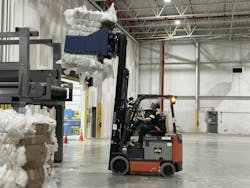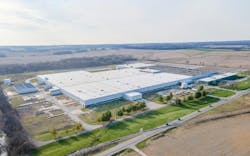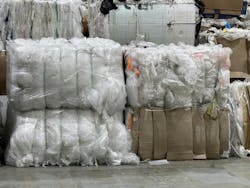From the Summer 2025 issue of Plastics Recycling.
By Chris Voloschuk
If you ask Alan Schrob, director of Mechanical Recycling at Calgary, Alberta-based Nova Chemicals Corp., he describes Connersville, Ind., as a “unicorn” location.
Situated just over an hour east of Indianapolis, the city has deep roots in manufacturing and rail access and is positioned between several metropolitan areas including Cincinnati; Chicago; and Louisville, Ky.
“In addition, we’ve been humbled by the warm welcome of the Connersville community,” Schrob says.
With all that in mind, Nova has deemed Connersville a perfect fit for its new linear low-density polyethylene (LLDPE) mechanical film recycling facility, Syndigo1, where postconsumer film collected from retailers and distribution centers is sorted, shredded, cleaned and turned into the company’s Syndigo brand of recycled PE (rPE) pellets for use in food- and nonfood-grade packaging.
Through its process, the company hopes not only to meet its customers’ postconsumer resin (PCR) demands, but also prove the consistency and viability of mechanical film recycling in North America.
Partner and packaging producer Novolex Holdings, LLC, based in Charlotte, N.C., is serving as the facility’s operator.
“This is a great example of a unique collaboration,” Greg DeKunder, vice president of Nova Circular Solutions, a Nova business unit that focuses on lower-emission, recycled solutions, said ahead of a facility tour in late February. “You don’t see it everywhere. … We’re taking actionable steps to solve the problem of circularity [for film].”
Creating jobs, filling a void
The Syndigo1 facility sits inside a massive 1.6 million-square-foot building that, until its 2008 closure, was a longtime automotive parts manufacturing facility and a major employer locally. Nova’s facility, which occupies 450,000 square feet and is capable of processing 12-14 million metric tons of postconsumer film per month, has brought with it about 125 new jobs.
“To be a part of the revitalization of this facility is really important to us,” Schrob says.
Inside the sprawling facility are four processing lines. Three currently are running, and Nova expects all four to be fully operational by 2026. The site also includes a large film bale storage area and a rPE pellet testing laboratory.
Once its Syndigo pellets are tested and ready for customers, Nova can ship by truck or rail via the facility’s on-site access.
“Connersville is uniquely located between Dayton [Ohio], Cincinnati, Indianapolis, Columbus [Ohio], Louisville, among others,” Schrob says. “A good portion of those locations are within a 250- to 300-mile radius. We have the capability to spread out to other areas as well.”
The location has unlocked a wealth of feedstock, and Nova and Novolex have made it a priority to audit suppliers and educate them on how to sort film from other materials in their own processes.
“[We remind them not to] put paper, hangers [and other items] in with film,” Novolex Chief Technology Officer Adrianne Tipton said during the February event. “We’re working through the process with retailers. If we can capture that plastic stream, that can be important to us.”
“Generators of this film wouldn’t view this as their core business, their core philosophy,” Schrob adds. “We want to make it as simple as possible for them to collect that film and for us to pick that up.”
The pursuit of pellets
Once employees load a film bale onto a conveyor in the storage area, the material goes through a fully automated mechanical recycling process.
First, bales are broken, with resulting wires and cardboard pushed off to the side and into bins for recycling into their respective markets. The film falls onto the conveyor in sheets, then passes through a shredder and is cut into 12-inch-by-12-inch squares.
Next, the pieces of film are conveyed to a vibrating screen that spreads them across the conveyor so the facility’s optical sorters can scan them and push them to the proper destination. Programmed to search for color and material type, the opticals can detect polystyrene, polypropylene, polyethylene terephthalate and more.
“We know exactly what yield we’re getting from these bales,” Schrob says. “We provide that feedback to suppliers to see how much PE we can get.”
After sorting, suitable film heads to a bunker to be shredded again into 1- or 2-inch squares, while undesirable film is sent to the third and fourth lines for an additional sort. Film deemed unsuitable for the Syndigo process is sold to plastic lumber and asphalt makers and advanced recyclers, Schrob says.
After the second round of shredding, the film goes through a series of washes that use friction and water to scrub off dirt and contaminants, then is dried, sent to a bunker and conveyed into a large densifier where it is turned into peanut-sized material. Next, it passes through an extruder, then undergoes a final screening and any remaining large particles are cleaned. From there, pellets that don’t meet Syndigo specifications are sent to bins to be sold.
In the final step, pellets are circulated in refreshers for several hours to eliminate all odors, which Schrob notes is an important step for food-grade rPE. Outside the facility are 13 silos to house the finished product, including one for off-spec pellets.
In the lab, Nova utilizes its testing methods for virgin PE on its recycled product before shipping it to customers.
“Many labs measure melt index, density [and more],” Schrob says. “We’re leveraging expertise from Nova’s virgin business for PE. We’re looking at taste and odor. [For example,] we have a camera that looks at gels to see how many gels [are in the film] and what size. Gel can break apart a film and create a visual issue. The camera measures gels that come across the line.”
Ready for new products
Nova’s mechanical recycling process received a letter of nonobjection (LNO) from the U.S. Food and Drug Administration (FDA) in June 2024, confirming its ability to produce PCR suitable for broad food-contact applications.
When it announced the LNO, the company said its customers will be able to use its Syndigo product at up to 100 percent recycled content for the manufacturing of food packaging intended to contact all food types under Conditions of Use B-H.
This May, the Connersville facility achieved Recycled Material Standard (RMS) certification from nonprofit GreenBlue verifying that Syndigo pellets are 100 percent postconsumer recycled content. The certification is earned through a rigorous series of audits and supply point verifications, and confirms that the facility meets all necessary requirements to trace feedstock to finished products.
“The RMS certification is the latest achievement for the Syndigo1 facility, and it underscores Nova Chemicals’ commitment to advancing circular solutions and sustainable packaging for flexible plastics,” DeKunder said in a certification announcement. “Beyond meeting RMS’ stringent traceability requirements, our customers can trust that they are receiving high-performing postconsumer recycled polyethylene.”
Syndigo pellets have garnered plenty of interest from the packaging sector, Nova says. In addition to its Novolex partnership, the company has inked offtake agreements with companies such as Amcor and Winpak, and Schrob says some room is being left for shorter-term contracts.
“We’ve had a great response from customers who are required to put mechanically recycled materials into their products,” he says.
High hopes for film recycling growth
Through its Connersville facility, Nova and Novolex are hoping to serve as a catalyst for the growth of film recycling.
“The market is still developing for recycled materials, film especially,” Schrob says. “A lot of it is collected and downcycled. A big opportunity for the industry is upcycling it into products that can be used over and over, or take it and put it into a process like ours.
“We’re working closely with a lot of retailers and distribution centers. We make it easy for film generators to move their material to Novolex. It’s synergistic between our customer base for collecting and creating circularity.”
At the February event, Novolex Chairman and CEO Stan Bikulege described the Nova partnership as a “unique, special relationship,” and expressed excitement for the opportunity for his company to operate the plant.
“We’re going to prove that you can do this,” Bikulege said of the recycling operation. “We’re going to get end products to the consumer. We’re driving circularity and it’s a huge step forward. It’s a big commitment, and we’re thankful for the opportunity.”
About the Author
Chris Voloschuk
Chris Voloschuk is Associate Editor of Recycling Today and can be reached at [email protected]. This story was published in Plastics Recycling, a joint publication of Plastics Machinery & Manufacturing and Recycling Today.


